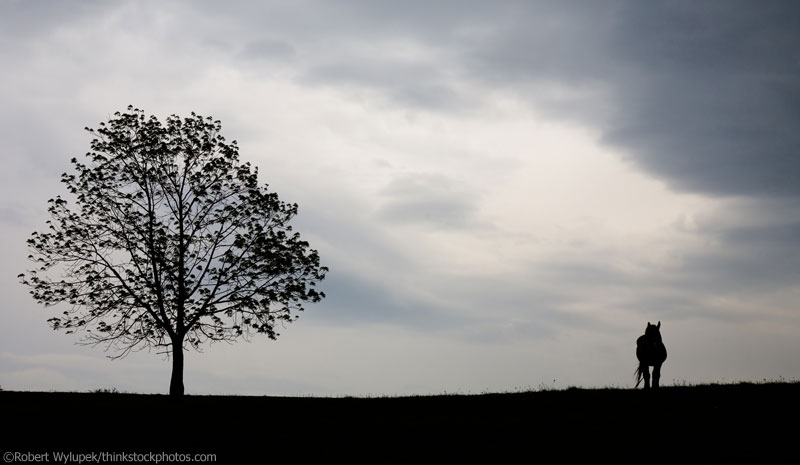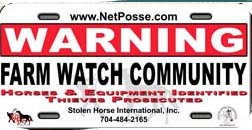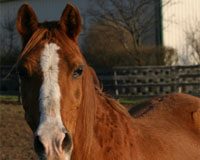
Horse lovers read these stories and expressed disgust toward the criminals and sympathy for owners across social media, but these are, unfortunately, not isolated incidents. Acts of mischief or cruelty against horses happen every day. We like to think of our barns as our sanctuaries. It’s important to be proactive in protecting those sanctuaries and the beloved animals that live there.
First Line of Defense
Even if you can’t invest in an expensive security system for your farm, you don’t have to feel helpless. There are some inexpensive things you can do to improve your security.
Debi Metcalfe is the founder of Stolen Horse International, also known as NetPosse.com. She travels to horse expos and events around the country educating farm managers and horse owners about security and theft prevention. Metcalfe hears about dozens of cases like the ones described above every week. Part of her job is helping horse owners avoid becoming victims of crime.
“Put up signs. A sign is your first line of defense,” says Metcalfe. “It can say ‘No Trespassing’ or ‘Horses Have Permanent Identification.’ People who [commit crimes] don’t want to mess with people who have knowledge; they like to attack the person who is totally clueless, because that person won’t know what to do. Criminals don’t want to get caught, and by posting a sign, you’re displaying that you have knowledge, and that means they might get caught.”
In the case of Catnip, a neighbor spotted two teenage boys leaving the property around the time the crime occurred and was able to provide a description to police. Because of this, law enforcement has a lead to follow. Having neighbors watch out for each other is often the best defense against crime.
“One of the best things you can do is have a farm watch community,” says Metcalfe. “We have some signs on our website that say “Farm Watch Community,” or you can make your own, and post those signs on your fences and on your property. And DO get the people in your community, and the local police, involved, like a neighborhood watch. If you see suspicious activities, report them to each other.
“If someone comes on to your property to look at your horses or ask for directions, take pictures,” Metcalfe continues. “Take a photo of their car and their license plate. Take a picture of the person. If they ask why you’re doing that, tell them! Explain that you’re part of a farm watch community, and you keep track of every visitor to the farm. It might be a totally innocent visit, but if it’s not, they’re going to go somewhere else.”
Create Alert Systems
Assess your farm by thinking like a criminal. Is it possible to walk on to the property in the dark without being seen or heard? That’s what criminals are looking for.
“Farm lights are great, but motion lights are better,” says Metcalfe. “A lot of us tend not to pay attention to the lights turning off and on after a while, but people coming on your property don’t know that.” A trespasser won’t want to take the risk of turning on a motion sensor light and potentially getting someone’s attention.
“Another thing you can do, especially if you’re in a rural area, is to have ‘natural alarms’,” Metcalfe continues. “You can have peacocks, guinea hens, donkeys, geese, and of course your dogs. Anything that will make noise when someone comes on to the property. Of course, then you have to pay attention to these alarms.
“If someone wants to do harm and is targeting you, they’re going to figure out a way to do it,” Metcalfe concedes. “But if it’s just a random act, they’re not going to risk getting caught. If there are two houses side-by-side and one makes a lot of noise while the other is completely silent, they’re going to choose the silent one.”
Preventing Theft
“We always promote identification,” says Metcalfe. “You never know when you’ll need ID, whether it’s because your horse runs away or gets stolen.
“Microchip is my favorite [form of ID] because it’s the quickest, easiest and cheapest, and it’s like a VIN (vehicle identification number) for your horse,” continues Metcalfe. “Freeze brands are a good ID, but sometimes people who find a marked horse don’t have the keycodes to read them, and then they don’t know what to do.”
A microchip kit can be purchased for approximately $20-50 and the microchip can be applied by a horse owner. However, you can also ask your vet to do it for you if you prefer. Metcalfe emphasizes that regardless of who does it, it’s important to follow the directions as the process for horses is different than the process for microchipping dogs and cats.
Use Your Head
As horsepeople, we view our farms as safe havens, and the idea of fortifying them against crime might seem to tarnish that idyllic image. But the truth is, crime can happen anywhere, whether it’s at the hands of a professional horse thief, an opportunistic vandal or a mentally unstable ex. It’s not fun to think about, but planning ahead for a bad situation could be the difference between a problem that you can resolve and a full-blown tragedy.
“If the worst-case scenario happens, what are you going to do?” says Metcalfe. “You have to plan ahead for these things, whether it’s a natural disaster, a manmade disaster, or a horse disaster. If you find your horse has been injured, who will you call first? What will you do? You have to keep a level head and act with some responsibility instead of with emotion, for your horse’s sake.”
By taking a few steps to protect your horse and property, you can give yourself some peace of mind and potentially avoid a heartbreaking situation.
Further Reading on Horse Theft Prevention:
Stolen Horse!
Horse Theft Prevention
Protect Your Horse from Theft







Excellent article! Extremely informative! Will definitely use these tips for when I get (hopefully!) a horse in the far future!!
great info
great info it amazes me how people can be so cruel hope they find the ones responsible and make them pay. there are some out that have no conscience or moral compass or knowledge of consequences to action I say bring back corporal punishment and put God back in our schools
We also installed video surveillance cameras after a problem we had. If you have the cameras you must post signs of notification on you property. We put up several signs. Our neighbors adore our horses and watch for people on our property and are not shy about asking what a visitor is doing there.
Our ADT Alarm signs help also.
We have motion sensor lights and we plan on installing Cameras also.
Costly but it does provide peace of mind :$
I am going to put up No Trespassing signs following this article – Thank You for the great advice
cool
It was a pleasure reading your well-written, timely and thoughtful article. My contribution is to microchip our equine community even tho I no longer own horses. Thank you so much for addressing the topic; it’s a pleasure to share it on social media!
Leslie, thank you so much for writing this educational and informative article. You did a fantastic job!!! As I told you when we talked, these stories break my heart. We will be glad to answer anyone questions if they contact us on NetPosse.com (Contact us button) or on our Facebook page, Stolen Horse International, Inc., aka NetPosse.com. We are here to help!!
They also have “Trip wire” alarms… a laser beam that when crossed emits a short, high pitched sound. Can be programmed to alert your phone too. We have them across every door in our barn, high enough that cats etc don’t set it off. It’s helpful for letting you know when someone goes in, or if a horse gets loose and comes out! Very inexpensive and a great device. We use the one made for garage doors 🙂
I microchipped my horse but that is my only line of defence. I hope nobody ever does anything to my horse!
Thanks for these great tips. I also wanted to add that, especially if you have unregistered (grade) horses like mine (all three are rescues), it’s crucial to have several clear photographs of each of your horse from every angle: front, both sides, and rear, clearly showing all markings. I’ve even gone so far as to ensure that I’m in the picture with the horse, and have some way to show the date, even if it’s a newspaper (don’t worry if that date doesn’t show up – it’s easy enough to track down that edition and compare it if a court needed the proof). This will help establish ownership so that you can prove the horses are indeed yours when they are recovered from a theft or during any ownership dispute!
Another thought is wildlife cams. They can be placed all over the farm.
Very good advise, I plan on following up on your suggestions.